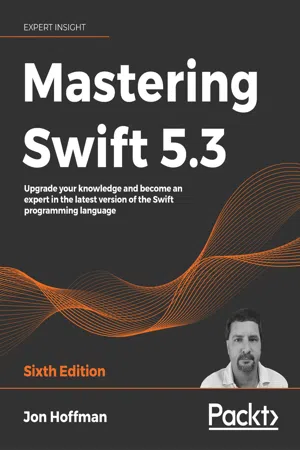
Mastering Swift 5.3
Upgrade your knowledge and become an expert in the latest version of the Swift programming language, 6th Edition
- 418 pages
- English
- ePUB (mobile friendly)
- Available on iOS & Android
Mastering Swift 5.3
Upgrade your knowledge and become an expert in the latest version of the Swift programming language, 6th Edition
About This Book
A comprehensive guide for programming enthusiasts who wish to gain a firm command of the fundamentals and advanced Swift concepts
Key Features
- Sixth edition of this bestselling book, improved and updated to cover the latest version of the Swift 5.3 programming language
- Get to grips with popular and modern design techniques to write easy-to-manage Swift code
- Use core Swift features such as concurrency, generics, and copy-on-write in your code
Book Description
Over the years, Mastering Swift has proven itself among developers as a popular choice for an in-depth and practical guide to the Swift programming language. This sixth edition comes with the latest features, an overall revision to align with Swift 5.3, and two new chapters on building swift from source and advanced operators.
From the basics of the language to popular features such as concurrency, generics, and memory management, this in-depth guide will help you develop your expertise and mastery of the language.
As you progress, you will gain practical insights into some of the most sophisticated elements in Swift development, including protocol extensions, error handling, and closures. The book will also show you how to use and apply them in your own projects. In later chapters, you will understand how to use the power of protocol-oriented programming to write flexible and easier-to-manage code in Swift. Finally, you will learn how to add the copy-on-write feature to your custom value types, along with understanding how to avoid memory management issues caused by strong reference cycles.
By the end of this Swift book, you will have mastered the Swift 5.3 language and developed the skills you need to effectively use its features to build robust applications.
What you will learn
- Understand core Swift components, such as operators, collections, control flows, and functions
- Identify how and when to use classes, structures, and enumerations
- Use protocol-oriented design with extensions to write easy-to-manage code
- Leverage design patterns with Swift to solve commonly occurring design problems
- Apply copy-on-write for your custom value types to improve performance
- Add concurrency to your applications using Grand Central Dispatch and operation queues
- Implement generics to write flexible and reusable code
Who this book is for
This book is for beginners with a basic understanding of programming and experienced developers looking to learn Swift programming. Familiarity with Apple's tools will be beneficial but not mandatory. All examples should also work on the Linux and Windows platforms
Frequently asked questions
Information
8
Classes, Structures, and Protocols
- What are classes and structures?
- How to add properties and property observers to classes and structures
- How to add methods to classes and structures
- How to add initializers to classes and structures
- How and when to use access controls
- How to create a class hierarchy
- How to extend a class
What are classes and structures?
Classes and structures are general-purpose, flexible constructs that become the building blocks of your program's code. You define properties and methods to add functionality to your classes and structures by using the already familiar syntax of constants, variables, and functions.
Similarities between classes and structures
- Properties: These are used to store information in our classes and structures
- Methods: These provide functionality for our classes and structures
- Initializers: These are used when initializing instances of our classes and structures
- Subscripts: These provide access to values using the subscript syntax
- Extensions: These help extend both classes and structures
Differences between classes and structures
- Type: A structure is a value type, while a class is a reference type
- Inheritance: A structure cannot inherit from other types, while a class can
- Deinitializers: Structures cannot have custom deinitializers, while a class can
Value versus reference types
Table of contents
- Preface
- Taking the First Steps with Swift
- Swift Documentation and Installing Swift
- Learning about Variables, Constants, Strings, and Operators
- Optional Types
- Using Swift Collections
- Control Flow
- Functions
- Classes, Structures, and Protocols
- Protocols and Protocol Extensions
- Protocol-Oriented Design
- Generics
- Error Handling and Availability
- Custom Subscripting
- Working with Closures
- Advanced and Custom Operators
- Concurrency and Parallelism in Swift
- Custom Value Types
- Memory Management
- Swift Formatting and Style Guide
- Adopting Design Patterns in Swift
- Other Books You May Enjoy
- Index